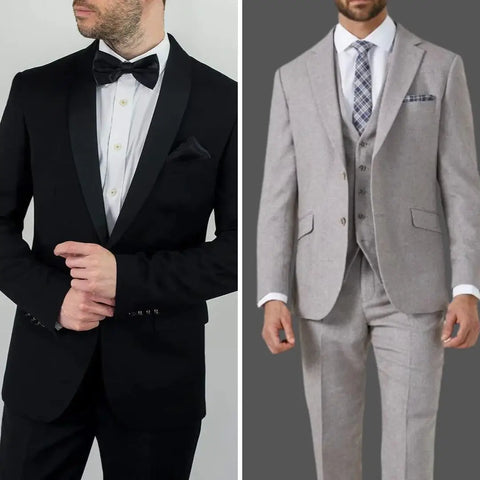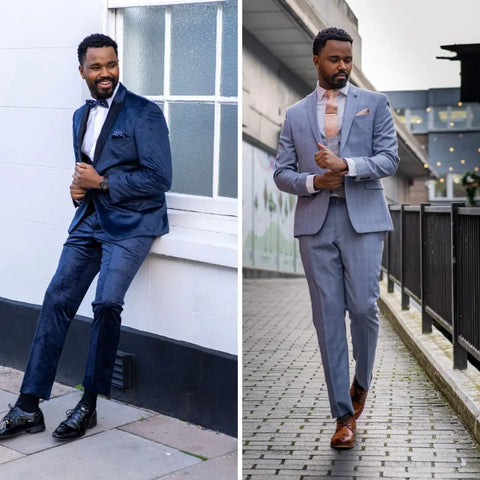Wonderful suite and professionally made
Nice Item quickly delivered. Highly recommended seller.
I received my costume and it was good quality as expected and well shaped for my body shape.

When it comes to dressing for formal occasions, the choice between a tuxedo and a suit can often leave many individuals perplexed. While both options are considered appropriate attire for formal events, there are distinct differences that set them apart.
From their overall aesthetic to their specific design details, understanding the dissimilarities between a tuxedo and a suit can help you make the right choice for your next special occasion. In this post, we will delve into the world of formalwear and explore the differences between a tuxedo and a suit.
One of the most noticeable differences between a tuxedo and a suit lies in their overall aesthetics. Tuxedos are typically associated with elegance, sophistication, and formal evening events. They are designed to make a strong fashion statement, with their distinct features setting them apart from everyday attire.

Tuxedos often feature satin or grosgrain lapels, satin-covered buttons, and a satin stripe down the sides of the trousers. On the other hand, suits have a more versatile and conservative look. They are commonly worn for business settings, weddings, and other formal events where a tuxedo might be considered too extravagant.
The jacket is a key component of both tuxedos and suits, and understanding the differences can help you make an informed decision. Tuxedo jackets are typically more formal and elegant in appearance. They often have a shawl collar, peaked lapels, or a notched lapel covered in satin or grosgrain fabric. The use of satin or grosgrain on the lapels creates a subtle contrast against the rest of the jacket's fabric.
Suit jackets, on the other hand, tend to have a more standard design. They usually feature notched lapels and are made from the same fabric as the rest of the suit.
Another distinguishing factor between tuxedos and suits lies in their trouser designs. Tuxedo trousers are often accompanied by a satin or grosgrain stripe running down the sides, adding a touch of formality. They are typically worn with suspenders or braces, as they usually lack belt loops.

Suit trousers, on the other hand, are simpler in design and often come with belt loops for the convenience of the wearer. They are usually worn with a belt to complete the ensemble.
The shirt and accessories worn with a tuxedo or a suit also differ to some extent. When wearing a tuxedo, a crisp white dress shirt is a must. It is traditionally accompanied by a black bow tie, although other options like a long tie or a necktie have become acceptable in recent years. In addition, a tuxedo is often paired with a cummerbund or a waistcoat, which adds a touch of sophistication to the overall look.
Suit shirts, on the other hand, offer more variety in terms of color and pattern choices. Ties can be worn in a wide range of styles, from traditional silk ties to more modern slim ties or even bow ties. The choice of accessories for a suit is generally more flexible and can be adapted to match the overall theme or personal style.
Tuxedos are typically reserved for black-tie events and formal evening affairs. They are often seen at weddings, galas, awards ceremonies, and other grand occasions. Suits, on the other hand, are more versatile and can be worn in a variety of formal and semi-formal settings. From business meetings to weddings and cocktail parties, suits are a safe and appropriate choice for a wide range of occasions.
While it is important to consider the guidelines and traditions associated with tuxedos and suits, personal style and preference should not be overlooked. Ultimately, feeling comfortable and confident in your attire is crucial. If you have a penchant for timeless elegance and want to make a grand impression at a black-tie event, a tuxedo might be the perfect choice for you.
On the other hand, if you prefer a more understated and versatile look that can be worn on multiple occasions, a well-tailored suit might be the better option.
the difference between a tuxedo and a suit lies in their overall aesthetics, jacket and trouser designs, shirt and accessory choices, as well as the occasions for which they are appropriate. While a tuxedo exudes a more formal and elegant aura, suits offer versatility and adaptability for a variety of formal and semi-formal events.
Ultimately, the choice between a tuxedo and a suit depends on your personal style, the event's dress code, and the impression you wish to make. So, the next time you find yourself faced with the choice between a tuxedo and a suit, consider these differences to help you make a well-informed decision.